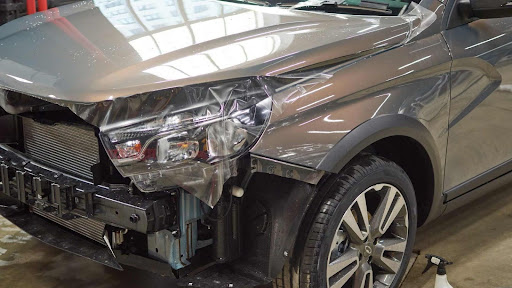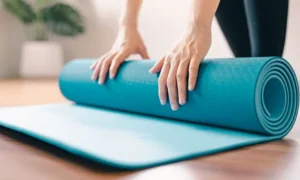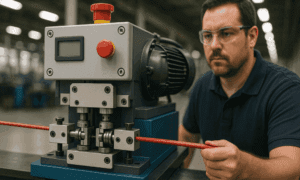Applying Paint Protection Film (PPF) to your vehicle is more than just a cosmetic upgrade. It’s an investment in your car’s durability and appearance. The installation process plays a key role in how well the film protects your paint from road debris, scratches, and other environmental damage. Whether you opt for professional help or a DIY approach, the installation method will determine how long the protection lasts and how effective it is. In this article, we’ll guide you through the essential steps of PPF installation and offer valuable tips to help you choose the right service.
The Paint Protection Film Installation Process
Paint protection film installation is a crucial step where product quality meets craftsmanship. This step will determine how well your vehicle stays protected. The right process gives you maximum durability and great looks, whether you choose professional help or try it yourself.
Professional vs. DIY Installation
Car owners need to make a big choice about paint protection film application. They can either get professional installation or do it themselves. This choice will affect their results, how long it lasts, and how happy they’ll be with the protection.
Professional PPF installation comes with clear benefits. Trained technicians know exactly how to work with thermoplastic urethane film. They also know how to handle tricky shapes and contours—places where PPF doesn’t stretch like vinyl wrap does. These experts use specialized tools, polyurethane squeegees, and heat guns made just for cars.
The results between professional and DIY installation are nowhere near the same. DIY jobs often show obvious flaws like air bubbles, edges that lift or poor alignment. These issues hurt both protection and looks. Even tiny mistakes can ruin large pieces of expensive PPF material. So trying to save money with DIY might get pricey later.
Professional installers work in clean rooms that keep dust and dirt from getting stuck under the film. On top of that, most good installers give warranty coverage for their work. DIY jobs can’t offer this peace of mind.
What to Expect During the Application Process
Professional PPF installers follow careful steps to get the best results. They start by getting your vehicle’s surface ready. This prep work has these steps:
- Complete washing to clean dirt and contaminants
- Clay bar treatment to remove stuck particles
- Isopropyl alcohol solution to clean off any oils
- Full drying to keep moisture out
Surface prep is a big deal—even tiny flaws or dirt can cause bubbles or wear out the film too soon.
Next comes the actual installation. Technicians pick pre-cut patterns that match your car’s make and model. Sometimes they custom-cut pieces for a perfect fit. They spray the film with slip solution (usually water mixed with baby shampoo) so they can position it just right.
The installers line up the film carefully. They use squeegees with strong, overlapping strokes to push out air bubbles and extra solution. Heat helps activate the adhesive and makes the film fit around curves. Edges need extra care, and temperatures sometimes go above 80 degrees Celsius for good adhesion.
Partial PPF jobs usually take 2–4 hours. Full-body coverage needs 4–8 hours. Bigger vehicles or ones with complex shapes might need a whole day or more. After installation, your car needs 24–48 hours to cure. During this time, you can’t wash it or expose it to harsh conditions.
Quality checks happen throughout the process. Installers look for and fix any flaws right away. Their attention to detail means your Paint Protection Film will last longer and work better.
How to Find Quality Vehicle Paint Protection Services
Your choice of a qualified installer is the most important decision you’ll make for paint protection film. Quality materials can fail if they’re not applied right, so picking the right installation service matters just as much as the product.
Essential Questions to Ask Potential Installers
Start by asking about the paint protection film brands they use. Watch out for vague answers about film brands – that’s a red flag. You should also ask them about their installation process. True professionals will walk you through their technique from prep work to final application.
The installer’s warranty tells you a lot about their confidence level. Quality installers back their work with solid warranties for materials and workmanship. Make sure to ask about:
- Manufacturer certification status and number
- Customization options for full vs. partial coverage
- Post-installation inspection procedures
- Recommended maintenance practices
Verifying Credentials and Reviewing Previous Work
Major PPF manufacturers’ certification is the gold standard in this field. All the same, don’t just rely on certification—get into their portfolio too. High-quality photos of their previous work show their craftsmanship. Ask to see examples of cars like yours. Look closely at how they handle edge wrapping, complex curves, and overall consistency in their finished work.
The Importance of Reviews and Recommendations
When you’re comparing several certified installers, customer reviews are a great way to get real insights about service quality. Look beyond the installer’s website and check independent platforms like forums and social media groups where customers share honest experiences.
Personal recommendations carry real weight. Talk to friends, family members, or car enthusiasts who’ve had paint protection film installed – they can point you to trustworthy providers. Local car clubs and dealerships might know some good installers in your area.
Book consultations with potential installers before you decide. Good professionals will listen to what you need instead of giving you a sales pitch. Their willingness to give personalized advice shows they care more about quality than profit.
Maintaining Your Paint Protection Film
Your paint protection film investment needs proper maintenance to last longer and work better. This protective layer can shield your vehicle’s paint from damage for more than a decade with good care. Let me show you how to keep your PPF looking pristine and performing at its best.
Proper Washing Techniques
Regular washing plays a significant role in keeping your paint protection film intact. Your vehicle needs gentle handwashing every1–2 weeks. The two-bucket method works best – one bucket with soapy water and another with clean water to rinse the wash mitt. This prevents dirt from getting back onto the surface.
You should first rinse your vehicle with low-pressure water to remove loose debris. The film’s edges might lift or get damaged from high-pressure washing. A garden hose works well, but make sure you keep it at a safe distance from the film.
Pre-soaking loosens dirt and grime before the actual wash. This reduces the risk of scratching your protective film. Make sure you wash in straight lines instead of circles, and work your way from top to bottom.
Products to Use and Avoid
The right products make all the difference in maintaining your car paint protection film. Pick a pH-neutral car shampoo made specifically for cars, with pH levels between 6 and 8. These mild formulations clean effectively without harming the film.
Soft microfiber towels work best for drying because they soak up water rather than push it around. This helps prevent streaks and scratches.
Products to avoid include:
- Petroleum or resin-based products that damage the PPF surface
- Abrasive brushes, paper products, or terry cloth
- Harsh chemicals like acetone, ammonia, or isopropyl alcohol
- Citrus-based or acidic cleaners
A ceramic coating on top of your PPF can enhance its protective properties. This extra layer helps guard against environmental contaminants and UV exposure.
Addressing Minor Damage
The paint protection film’s self-healing abilities take care of minor scratches naturally. Small surface imperfections disappear after leaving your vehicle in the sun for 25–30 minutes. Warm water poured over the scratched area speeds up this healing process.
Detailing clay removes stubborn contaminants that regular washing misses. In spite of that, if you spot bubbling under the film, use a small pin to carefully release trapped air. Then smooth out the film gently with your fingertips.
Regular inspections help catch potential issues early. Look for lifted edges, bubbles, or damage signs that might need professional help. Quick action on small problems stops them from becoming major issues that could affect the film’s protection.
Conclusion
When it comes to paint protection film, proper installation is crucial for achieving lasting protection and a flawless finish. While DIY applications can seem appealing, they often lack the precision and expertise that professional installers bring to the table. By choosing qualified installers who use top-tier materials and follow a detailed process, you can maximize your vehicle’s protection. Regular maintenance will ensure your PPF remains effective and keeps your car looking its best. Explore the full range of web development services here to learn more about technology-driven solutions.





























